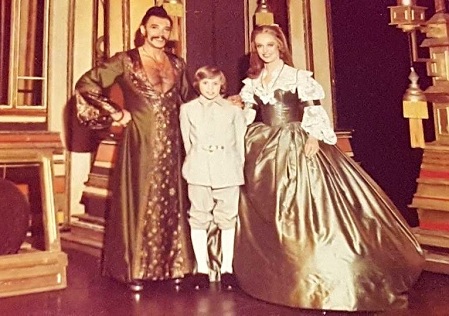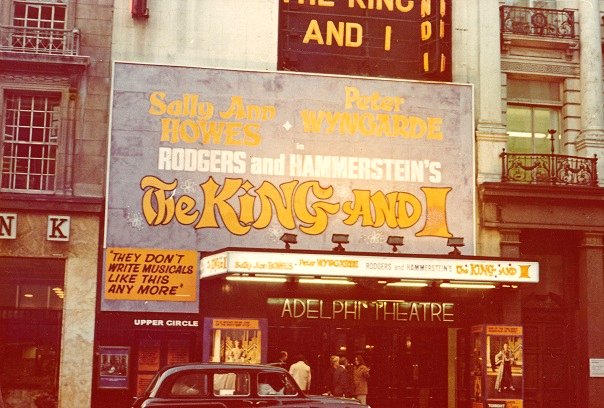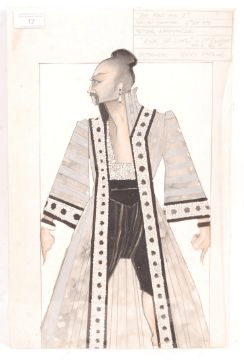
Presented by Triumph Theatre Productions: British National Tour and at the Adelphi Theatre, London 1973.
Character: The King of Siam
“Yes, Louis, I like him very much indeed!” Anna Leonowens – speaking of the King
Whether or not you believe in the basic idea of the Victorian governess taming the Eastern despot to bring Siam into the orbit of Western ideas, Sally Anne Howes shone brilliantly as Anna Leonowens – singing, acting and dancing superbly opposite Peter Wyngarde as King Mongkut, who had the formidable task of playing the part associated so strongly with Yul Brynner. He gave a harsher, more barbaric conception of the role, and in doing so, succeeded to a remarkable degree in exorcising the ghost of his predecessor.
When this Forum Billingham production hit the London stage in October of 1973, it had been almost twenty years to the day from the very first performance of Rodgers’ and Hammerstein’s musical on Drury Lane. Through the years its tunes had kept alive the memories of the barbaric King of Siam’s conflict with the genteel English Governess. Now once more, Victorian primness mingled with Eastern dignity and pageantry in a truly first-class revival.
Undoubtedly, the strengths of this likeable musical were the score and the sentimental use of the King’s children – each of whom had their tiny bit of business to perform, and their efforts were rewarded with enough applause to make their seniors green with envy – though they too were given an astonishingly warm welcome. Songs such as “Hello Young Lovers”, “Getting To Know You” and “Shall We Dance?” were greeted by the enthusiastic sell-out audience at each and every performance as if they were old friends, and the singing too was exceptionally well executed, particularly by Ms Howes, who showed an authority on stage few critics thought she possessed.
With Peter, however, we leave the sphere of music for that of acting, for although he had a number or two that he performed in a half-spoken, half-sung style, his portrayal of the King moved from cruel autocracy to the “civilization” of the Western World that he could only half comprehend, and touched depths of understanding rarely ever encountered in a musical. With his hair drawn back into a top-knot at the crown and with his circumflex moustache remaining to remind us that he’d once been the debonair Jason King, he built up an imaginary character rather as Robert Stephens did with his Atahualipa; lacking any real knowledge of the actual man, he assembled a collection of characteristics which the audience were quite willing to accept as the real thing.
In King Mongkut, Peter portrayed a contradictory combination of charm and cruelty, of feudal instincts and of a desire to progress which was epitomized in the performance of David Morris as his eldest son, Crown Prince Chululongkorn, who has recognized the need for change but who has remained totally loyal to his father. Nevertheless, Peter made a dashing enough King, especially when the Governess, swaying and swooning in her crinoline, teaches him to waltz.

Left: Peter and Sally Anne Howes perform the famous ‘Shall We Dance’ sequence
Although he may have lacked the bulk and authority of Yul Brynner, Peter still managed the role in a style that was personal, charming and finally, moving. His unique interpretation gave the King a more abrasive approach to any problems arising. With feet astride, hands on hips and head tilted sideways, Peter was the complete dictator, yet at the same time, he injected a touch of humour, not only in his facial and finger-waving gestures, which immediately endeared him to the audience. Dressed in a series of embroidered house-coats by Jasper ver Deep décolletage which revealed his somewhat unSiamesely hairy chest, Peter portrayed the role with his usual air of flamboyance, and was totally convincing as both the monarch and savage, but coming into his own in the final quiet moments.
Even those who are not particularly sympathetic to the idiom of the musical would have probably enjoyed this show and then been caught up in its sentimental, but not maudlin, story. From the moment that we see the English widow arrive in Bangkok in the 1860’s, as governess to the King’s children, to discovering that there are over 60 of them with another dozen or so on the way, we are swept along by the enchanting tale which stems from the difference between the Eastern and Western way of life, and on the mutual respect and love which develops between Anna and the King.

Above: Peter as the King, with Stephen Grover as Louis Leonowens and Patricia Michael, who took over as Anna Leonowens when Sally Anne Howes left the production.
In Retrospect
‘Showboat’ had hoisted its anchor and Rogers and Hammerstein’s Siamese classic had taken its place on London’s Drury Lane for the autumn and Christmas season in 1973. However, the American musical was committed in the main to proving that the advent of the British Governess was a good thing for Siam. Whistling her happy tune, she infected the downtrodden with courage; she mounted a dramatization of ‘Uncle Tom’s Cabin’ which helped to persuade the King that absconding lovers should not be punished; and the sight of a woman standing up to his bad tempered father proved to Prince Chululongkorn that when he eventually becomes king, no one would need to grovel.
This remarkably handsome revival appeared a good deal more acceptable to theatre-goers than the rather messy versions which had preceded it over the years. It did not aspire to the splendours of the original version at the Adelphi, but it did not skimp either; the settings were elegant and tasteful, the orchestra made an impressive sound, and only the lighting seemed a little hesitant.
In the lead roles, Peter and Sally Anne Howes made stately and appealing work of playing the barbarian King and the widowed Governess, and of whom Duncan C. Wheldon, director of Triumph Theatre Productions described as, “An absolutely delightful couple.”
Of course, many people would’ve had the vision of Yul Brynner and Deborah Kerr etched in their minds when they took their seats at the opening night. Well, that was too bad for Mr Brynner and Ms Kerr! Peter, with his shaggy mane swept back into a top-knot and his famous Zapata moustache in its usual villainous droop, stood astride on his padded throne, and succeeded in instilling a deal of sheer acting into the role. There were many moments when the chemistry between he and Ms Howes was so effective that the action developed a genuine dramatic tension. Although it must be said that he sometimes looked uneasy in his role as the savage, he did come into his own in the quieter moments, and his moving portrayal of the King’s death in the final scene.
Regal Facts

Right: A distraught Mrs Anna with the dead King.
- More than 400 youngsters were auditioned for the parts of the Kings children – 56 of them were finally chosen. Three groups of 8 to 14-year-olds worked on a rota basis to perform on alternate nights of the week, with one group of stand-ins. Amongst the group of 11-year-olds was Charlotte Barker – daughter of comedian, Ronnie.
- The play visited most of Britain’s principal theatres during a 12 week period during the summer of 1973, before reaching the West End of London on Wednesday, October 10th of that year.
- After Peter and Sally Ann Howe’s dined together at Mario and Franco’s Terrazza restaurant during the plays visit to the Grand Theatre in Leeds, the head Chef was said to be so delighted to see his famous clients that he served up a rather special dish the following day, called Medallions De Veau a’la Jason.
- On September 13th, 1973, Peter and Sally Ann Howes sailed into the Pool of London on the Chinese junk, the Hoi Lung (Sea Dragon), in full costume to publicise the opening of the show in the West End. (See newspaper cutting).
- Peter sang three songs in play: ‘A Puzzlement’ in Act 1; ‘The Song of the King’ (with Anna) and ‘Shall We Dance?” (with Anna) in Act 2.
- The management of the Adelphi theatre in Drury Lane reported that they were unable to cope with the demand from female patrons asking for opera-style binoculars, as those in the Upper Circle and Rear Stalls were desperate to get a close-up view of Peter!
- The production boasted an orchestra of over sixty musicians, and the sets were designed by the legendary Terry Pearson.
- After every energetic performance of the famous ‘Shall We Dance?’ segment, the audience would demand an equally energetic encore of the waltz. Although always happy to oblige, due to the sweltering heat from the theatre lights and the weight of the heavy costumes, Peter and his co-star, Sally Anne Howes, would be given oxygen in the wings before they were able to go back on stage.
- The demand for tickets was so great that the West End run would be extended. However, Sally Ann Howes had already signed a contract to appear in another play in the United States. Her part was taken by Patricia Michael.
- Whilst playing at the Adelphi Theatre, a block-booking was made by 400 teenage girls – all of whom raced to the stage door after the show in the hope of catching a glimpse of Peter.
- As it’s a custom for the actors in a play to exchange presents, Peter gave Sally Ann Howes a huge sculptured elephant, handmade by craftsmen in Thailand.
- Remembering that the King wears glasses in the show, she gave him a pair of Georgian spectacles. He had the lenses taken out of them, and wore them on stage.
- Peter appeared in all 260 performances of the play.

Above: The Adelphi Theatre in London at the time that ‘The King and I’ was playing there.
Critics Comments
| “...Peter Wyngarde’s King is positively endearing…” The Sunday Telegraph – October 1973 “An English schoolmarm highhandedly civilizes the King and his family. Peter, number one son of Siam, was ah-so very good, while Sally Ann Howes made a delightful Anna. Together they make a loveable couple which should keep the coaches coming in.” The Daily Mail – October 17th – 1973 “…Peter Wyngarde has an enchanting humour with which he makes the part anew. He and Sally Ann Howes are a delightful couple and I can only wish them the happiness they gave me last night.” The Evening News “Peter Wyngarde touches depths of understanding not always encountered in a musical. This is a spectacle indeed.” The Financial Times “…Peter Wyngardeis personal, charming and finally moving. It wouldn’t surprise me if the show announced limited run stretches on and on well into the New Year. And beyond.” The Daily Express – October 1973 “Sally Ann Howes makes a charming Anna, while the ruler is played by Peter Wyngarde with splendid arrogance.” The Sunday Express |
Below: A rare original costume design artwork panel for Peter in the 1973 UK Touring production of ‘ The King And I’.

The original costume design artwork by Terry Parsons, and shows the outfit as worn by Peter in Act I Scene II. Watercolour and mixed media on board. Pencil details to top corner. Rare piece of theatre history. Measures approximately; 44cm x 29cm.
Click below for more about ‘The King and I’
The Hellfire Club: The OFFICIAL PETER WYNGARDE Appreciation Society: https://www.facebook.com/groups/813997125389790/


3 thoughts on “REVIEW: The King and I”